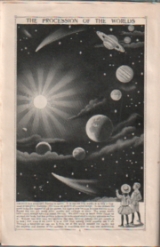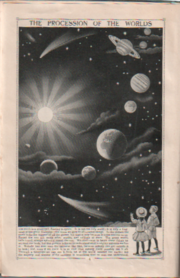
The Children's Encyclopedia
Encyclopedia

Arthur Mee
Arthur Henry Mee was a British writer, journalist and educator. He is best known for The Harmsworth Self-Educator, The Children's Encyclopaedia, The Children's Newspaper, and The King's England...
, and published by the Educational Book Company, a subsidiary of Amalgamated Press of London. It was published from 1908 to 1964. Walter M. Jackson
Walter Montgomery Jackson
Walter Montgomery Jackson was the founder of encyclopedia publisher Grolier, Inc., and he was the partner of Horace Everett Hooper in publishing the 10th edition of the Encyclopædia Britannica and in developing its 11th edition...
's company Grolier
Grolier
Grolier was one of the largest U.S. publishers of general encyclopedias, including The Book of Knowledge , The New Book of Knowledge , The New Book of Popular Science , Encyclopedia Americana , Academic American Encyclopedia , and numerous incarnations of The Electronic Encyclopedia .Grolier was an...
acquired the rights to publish it in the U.S. under the name The Book of Knowledge (1910).
Format and descriptions
The encyclopædia was originally in fortnightly parts between March 1908 and February 1910. Some readers could have bound their collections, but the first eight-volume sets were published in 1910. Each section contained a variety of articles, developing topics as it progressed. The work could be used as a conventional reference library, as the last volume had an alphabetical index, or each section could be read from start to finish. It was originally organised into sections but there were changes in subsequent editions. Some titles covered scientific subjects such as geologyGeology
Geology is the science comprising the study of solid Earth, the rocks of which it is composed, and the processes by which it evolves. Geology gives insight into the history of the Earth, as it provides the primary evidence for plate tectonics, the evolutionary history of life, and past climates...
, biology
Biology
Biology is a natural science concerned with the study of life and living organisms, including their structure, function, growth, origin, evolution, distribution, and taxonomy. Biology is a vast subject containing many subdivisions, topics, and disciplines...
and astronomy
Astronomy
Astronomy is a natural science that deals with the study of celestial objects and phenomena that originate outside the atmosphere of Earth...
but such scientific terms were generally avoided.
- Familiar Things, by "Many writers"
- Wonder, by "The Wise Man"
- Nature, by Ernest Bryant and Edward StepEdward StepEdward Step was the author of books on various aspects of nature. He produced many books on insects, shellfish, trees and flowers, which were published between 1896 and 1940. Those on flowers were beautifully illustrated, some if not all by Mabel Emily Step...
- The Child’s Own Life, by Dr. Caleb SaleebyCaleb SaleebyDr. Caleb Williams Saleeby was a doctor, writer, and journalist in the United Kingdom known for his support of eugenics, the idea of taking active measures "aimed at improving the genetic composition of a population"...
- The Earth, by Dr. Caleb SaleebyCaleb SaleebyDr. Caleb Williams Saleeby was a doctor, writer, and journalist in the United Kingdom known for his support of eugenics, the idea of taking active measures "aimed at improving the genetic composition of a population"...
- All Countries, by Frances EppsFrances EppsFrances Epps was an English writer of educational works for children, a role in which she was particularly gifted. There is no biography, and even her dates of birth and death are unknown....
- Great Lives, by "Many writers"
- Golden Deeds, by "Many writers"
- Bible Stories, by Harold Begbie
- Famous Books, by John Hammerton
- Stories, by Edward Wright
- Poetry, by John Hammerton
- School Lessons, by several writers, including Lois Mee, Arthur's sister
- Things To Make and Things To Do, by "Many writers"
Mee wrote a "Greeting" and a "Farewell". He took a strong interest in the "Book of Wonder", in which the "Wise Man" answered questions by children.
The illustrations were mostly anonymous but some illustrators included Susan Beatrice Pearse
Susan Beatrice Pearse
Susan Beatrice Pearse was a British illustrator of children's books and creator of images for postcards and greeting cards. She is best known for her work on the Ameliaranne series of children's books...
, C. E. Brock
C. E. Brock
Charles Edmund Brock was a widely published English line artist and book illustrator, who signed his work C. E. Brock. He was the eldest of four artist brothers, including Henry Matthew Brock, also an illustrator....
, Thomas Maybank, George F. Morrell, Dudley Heath, Charles Folkard, H. R. Millar, Alexander Francis Lydon, Arthur A. Dixon and Arthur Rackham
Arthur Rackham
Arthur Rackham was an English book illustrator.-Biography:Rackham was born in London as one of 12 children. At the age of 18, he worked as a clerk at the Westminster Fire Office and began studying part-time at the Lambeth School of Art.In 1892 he left his job and started working for The...
. The books used photographs by Frank Hinkins
Frank Hinkins
Francis Robert "Frank" Hinkins was an English author, photographer and illustrator. Among his works were Romany Life and Water-colour drawings of British spiders and their webs ; he is best known for contributing many of the photographs in his friend Arthur Mee's famous book The...
, engravings, maps and graphics.
The Encyclopædia broke ground in the approach to education, aiming to make learning interesting and enjoyable. Its articles were clearly written. It aimed to develop character and sense of duty.
Articles reflected its authors: they were proud of Britain and the British Empire; religion – Christianity was held to be the only true religion; racism – the white race was superior, and there were hints of the eugenic ideas of Caleb Saleeby
Caleb Saleeby
Dr. Caleb Williams Saleeby was a doctor, writer, and journalist in the United Kingdom known for his support of eugenics, the idea of taking active measures "aimed at improving the genetic composition of a population"...
. Offsetting this was a moderate and liberal standpoint in many areas: other races might be inferior, but they should be treated with respect, and imperialism was justified only if it improved the lot of its subjects. At a time when the relation between science and religion was controversial, the Encyclopædia supported evolution
Evolution
Evolution is any change across successive generations in the heritable characteristics of biological populations. Evolutionary processes give rise to diversity at every level of biological organisation, including species, individual organisms and molecules such as DNA and proteins.Life on Earth...
, but it did not admit any contradiction between the two.
It was sold door-to-door. It was used by schools and for teacher training. It gives insight into the social values of the society that created it and was influenced by it.As the initial run ended, it was reissued as the monthly New Children's Encyclopædia. The title changed, becoming Children's Encyclopædia Magazine, Children's Magazine and, finally, My Magazine in 1914. From September 1910, the magazine
Magazine
Magazines, periodicals, glossies or serials are publications, generally published on a regular schedule, containing a variety of articles. They are generally financed by advertising, by a purchase price, by pre-paid magazine subscriptions, or all three...
included a supplement of news entitled The Little Paper, the forerunner of Arthur Mee's Children's Newspaper, launched in 1919.
The Children's Encyclopædia sold 800,000 copies in 12 editions before being extensively revised in the early 1920s. The new 59-part, 7,412-page, 10-volume series debuted in October 1922 as The Children's Encyclopedia, the digraph
Digraph (orthography)
A digraph or digram is a pair of characters used to write one phoneme or a sequence of phonemes that does not correspond to the normal values of the two characters combined...
having been dropped, and went through 14 editions by 1946 under the imprint of The Educational Book Co.. Translations appeared in France, Italy, Spain and China.
New editions of the Encyclopedia continued after Mee's death in 1943; the final, much revised, edition, still entitled Arthur Mee's Children's Encyclopedia, appeared in 1964.

